Searching for Shade and Ticks : St. Malo to Some Trees
The American Redstart was singing loudly from its perch above our tent as we packed up, and the sweet sounds of American Robins could be heard throughout the campground. Cedar Waxwings were foraging in the treetops, a White-breasted Nuthatch was making its way up an aspen trunk, and a Gray Catbird was burbling away in a shrub nearby. As we made our way past the long sandy beach, the red sun rose above the horizon, and a brilliantly coloured Yellow-bellied Sapsucker drummed on the aspen beside us.
In the deliciously cool morning air we followed the Trans Canada Trail out of the provincial park and into the small town of Saint Malo.
The road around the lake was surrounded by small homes and cottages, and in one front yard we spotted a Brown Thrasher on the lawn, hanging out with several Killdeer. In a stand of trembling aspen at the edge of another property we stopped to watch a pair of Eastern Kingbirds.
As the morning progressed we found ourselves walking through hay fields and pastures on the Crow Wing Trail. One of the things we've enjoyed about hiking in the prairies is the wildflowers along the edges of the road, and in this less-intensively managed landscape there was an abundance of colourful flowers. In some places we could hear the bees busily pollinating the white, yellow, orange, and purple blooms, and we enjoyed their sweet smell on the breeze.
A little farther on we passed a pasture filled with curious black cows. Until they caught sight of us they were contentedly grazing, their large wet noses tracking back and forth in the lush grass in search of tasty mouthfuls. A flock of Brown-headed Cowbirds was foraging for insects in the patches of grass and earth disturbed by the grazing cows, sometimes coming so close to the animals that it looked like the birds were directly under the cow's noses and in danger of being munched on.
A little farther along we were treated to a section of trail that was a grassy track. Perhaps more of an ATV trail than anything, it provided a nice change from the gravel roads. We enjoyed the softer surface and the coolness of the shade, but like everything in life, there was a price to be paid. Every few hundred meters we had to stop and remove the ticks from our socks and legs. Despite tucking the legs of my pants into my socks in a classic naturalist's crime against fashion, I had 12 ticks attach themselves to my legs over the course of the day. Totally disgusting and disturbingly inexplicable. If we stood still for more than 30 seconds we could see them begin to climb up our shoes, and by the end of the day we were convinced the ticks here could either fly or ride the breeze.
The next highlight in our day came in the form of a mowed grass trail section. The forest on both sides was filled with birds of the deciduous forest, including Ovenbirds, Rose-breasted Grosbeaks, Red-eyed Vireos, Hermit Thrush, and an Eastern Wood-pewee. There was a barbed wire fence on both sides of the trail, making us wonder what was being fenced in, or out. Maybe it was us. Either way, we were grateful for the shade of the forested oasis.
A little farther down the trail we passed a small cattail marsh surrounded by natural vegetation. We were once again struck by now much life was supported by this tiny bit of water. An Olive-sided Flycatcher was giving his distinctive order of 'Quick three beers!' A Common Yellowthroat was stealthily feeding young in the cattails, a Yellow Warbler was preening on a branch, and of course an abundance of Red-winged Blackbirds were adding their voices to the mix. In the distance we could hear the ancient, rolling, dry calls of Sandhill Cranes!
As we made our way along the dry concession roads we were very pleased to see swallow boxes along the edges of several fields and horse pastures. To make things even better the boxes were occupied by a lively group of Tree Swallows, who were busy feeding nestlings. Pausing to take photos of these beautiful birds made us realize that photographing prairie birds is as different as learning to find them. They seem much more skittish than city or forest birds, flying away long before you can get close enough to take a photo. Normally distance wouldn't be a problem with a zoom lens, but here everything beyond a few meters is obscured by the heat haze, making it seem more like an impressionist painting than something a nature photographer would be proud to show.
By early afternoon we found ourselves walking past the Nativity of St. Mary Ukrainian Orthodox Church in Senkiw. The first Ukrainians came to Canada in the early 1890's, and between 1896 and 1914 around 170,000 Ukrainians arrived from the overcrowded provinces of Galicia and Bukovyna. Many sold their farms due to increasing land taxes and decreasing land availability in the Ukraine, and moved to the Canadian prairies to begin again. At this time the Canadian government was actively recruiting experienced farmers to settle the prairies.
Outside the church was a monument to the Ukrainian pioneers, and a little farther along the road was a commemorative plaque for a Ukrainian school. From 1906 to 1967 local children, most of whom belonged to Ukrainian immigrants, attended school in a one room schoolhouse, and their textbooks were apparently in English and Ukrainian. Until 1947 children from the far side of the Roseau River had to cross it using a hand-powered cable basket. After this a suspension bridge was built, which was used until 1967, when it fell into disrepair.
In 2005 the modern Senkiw Swinging Bridge was built as part of the Trans Canada and Crow Wing Trails. This section of pathway is 3.7 km long, and it took us through an open section of grassy prairie and a beautiful deciduous forest. As we crossed the prairies the sun was shining and the heat was beginning to climb, so we were grateful to dive into the forest and make our way down a steep dirt track to the edge of the river.
When we reached the famous suspension bridge we discovered it is incredibly narrow, and does in fact swing quite actively in the middle. We waited for a family of four to cross, the two young girls bouncing and swinging as much as possible. Then we awkwardly ducked under a very low cable, and with relief discovered that the bridge itself was just wide enough for us to push our carts across, saving us quite a few headaches. At the far end we found a very steep set of stairs which ended in a tight turn around the anchor of the bridge, which essentially was a mechanism formed by huge chains held in place by bits of iron farming machinery.
We took a break at the picnic tables located in the shade at the end of the bridge, and were soon joined by several other families out enjoying the hot summer weather. It seemed like braving the narrow and unsteady bridge provided a satisfying challenge to old and young alike.
After a short break we made our way up out of the river valley on a long flight of earth stairs. Without the carts this wouldn't have been difficult at all, but hauling them up gave us quite a workout, which left us feeling unpleasantly overheated and zapped of energy. In the next section of trail things didn't improve.
Since we'd received a text from Bell welcoming us to the US and warning us of horrendous sounding roaming fees for data usage, we turned off the phone and decided to simply follow the trail signs. We walked to the end of a gravel road without incident, looking forward to a forested section of trail at the end. When we reached the anticipated off-road section however we ran into difficulties.
We came to a fork in the trail, one branch of which led down a very steep, loose mud trail to the river, and the other branch of which followed a grassy track around the edge of the field. We decided it was easier to pull our carts along the grassy track, and this is what the trail App had indicated was the correct route. At the far edge of the field we spotted trail signs directing us into the forest. So far so good. However, almost immediately conditions deteriorated.
We followed a rocky trail down a steep, forested hill, crossing a metal pipe that was being used to pump water up from the river below to a large sprinkler system in the soy field above. The water in the river was already very low, making us wonder how much more could be used for irrigation before the river dried up entirely. From there we followed a newly cut footpath that snaked up and down the steep hill, often causing our carts to tip sideways on the uneven hillside. Fallen trees and slash blocked our way on many occasions, making the going extremely tough on the brutally hit afternoon. It turned out that more land was being cleared for agriculture, and possibly some Hydro company work was being undertaken. For some reason the farmer wasn't selling the large pile of cut wood, but simply burning it in the field above us. Several times we tried to escape the obstacle ridden footpath, but we were hemmed in by barbed wire and 5 ft tall slash piles. Our much anticipated section of shady forest was replaced with frustration and time consuming struggles. Without our carts it likely would have been a pleasant, if poison ivy strewn hike.
Shortly after this the trail took us alongside the Roseau Rapids 2A Reserve Lands. The Roseau Rapids Reserve has just over 2,000 registered inhabitants from the Roseau River Anishinabe First Nation, and it is divided into three parts, with 2A being only 3.23 sq km. The land surrounding the Reserve is now part of Treaty 1 Territory.
We had anticipated another short section of forested trail here, but again we were disappointed. Instead of leading into the woods, the TCT signs were tossed in the ditch and the Manitoba trail signs directed us straight down open, shadeless, gravel concession roads. We passed several homes with 'No Trespassing Anymore' and 'Do Not Enter' signs, hinting at a disagreement or tension between the residents and the trail that we knew nothing about.
So, as the heat continued to climb we walked the gravel concessions under a blazing sun. As we made our way along the dusty roads one man stopped his pickup truck to ask what we were up to and to chat about the weather. Another gentlemen stopped to chat and to offer us a piece of hard candy to combat thirst. Others passed us in a cloud of dust without slowing down or pulling over.
Finally we ducked into a small forest with an adjacent marsh, where we gratefully took shelter in the shade. We put our tarp on the grassy and poison ivy laden trail and sat down, intending to take a break for a couple of hours and continue on when the heat abated somewhat. We listened to the songs of a Gray Catbird, a Baltimore Oriole, an Ovenbird, and an Eastern Wood-pewee as we waited patiently. We had to defend our small tarp against the constant invasion of ticks, while at the same time providing a juicy meal for the mosquitoes.
By 6:30 pm we thought it had cooled down enough to continue on, and we packed up and moved to the other end of the woodlot. It was immediately obvious that it was still too hot to head out down the next 11 km of shadeless concessions, so we hunkered down to wait some more in the shade.
As the sun began to sink lower towards the horizon a White-tailed Deer appeared in the adjacent field, and a pair of Upland Sandpipers began circling above the wheat field, calling incessantly. At 7:30 we finally decided to call it quits for the night and pitch the tent in the quiet little woodlot. As we did so a surprisingly large skunk came trundling along the trail, approaching to within a few feet of us before running off down the trail, tail raised high.
As darkness fell a truly impressive swarm of mosquitoes descended on us, and we were very grateful for the shelter of our tent. Finally, as we searched our clothes and bodies for ticks (18 in total tonight) a very long day had come to an end.
See you on the trail!
Remember to follow our entire adventure here : www.comewalkwithus.online
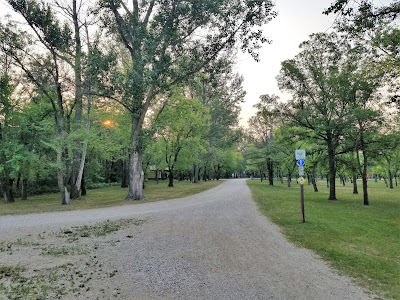
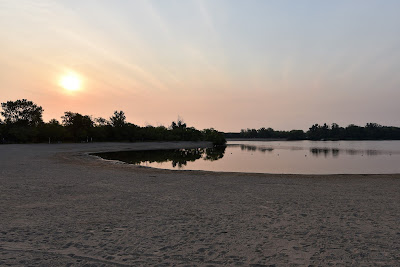

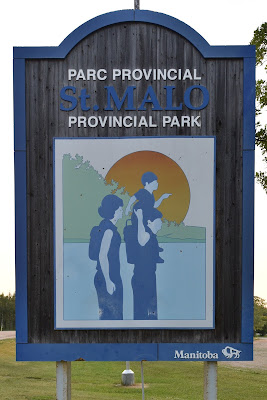


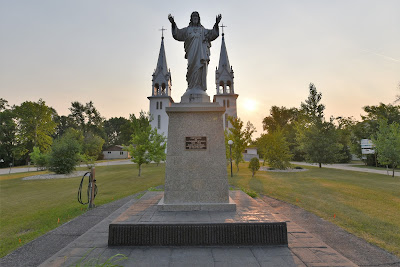















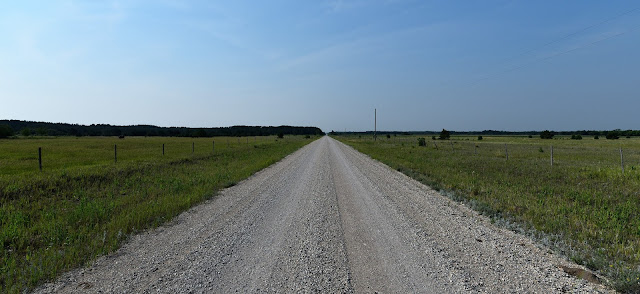









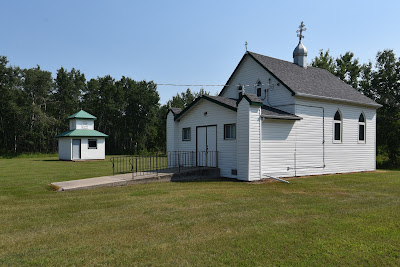









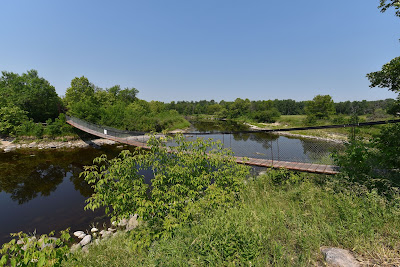




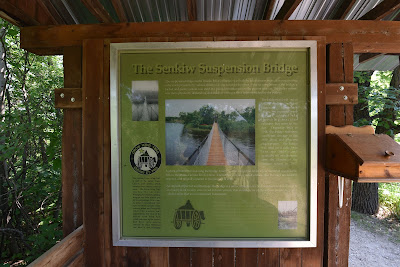
































Comments
Post a Comment